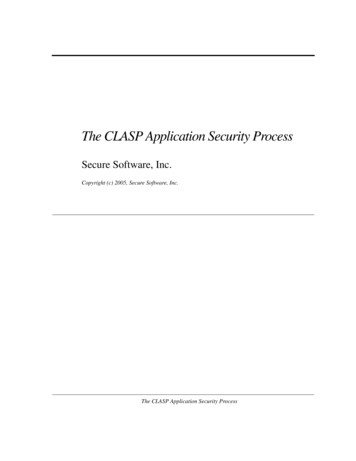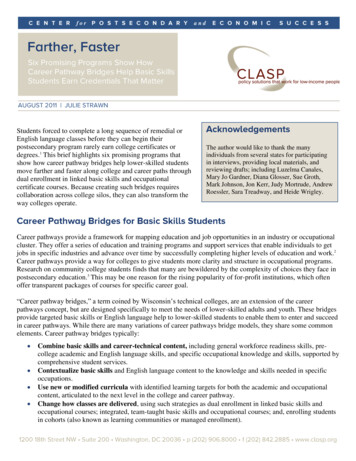
Transcription
Full ReportSTATE INITIATIVES TO PROMOTE EARLY LEARNING:NEXT STEPS IN COORDINATING SUBSIDIZED CHILD CARE,HEAD START, AND STATE PREKINDERGARTENCenter for Law and Social PolicyBy Rachel Schumacher, Mark Greenberg, and Joan LombardiApril 2001
STATE INITIATIVES TOPROMOTE EARLY LEARNING:NEXT STEPS IN COORDINATINGSUBSIDIZED CHILD CARE, HEAD START,AND STATE PREKINDERGARTENBy Rachel Schumacher, Mark Greenberg and Joan LombardiApril 2001
STATE INITIATIVES TO PROMOTE EARLY LEARNING:NEXT STEPS IN COORDINATING SUBSIDIZED CHILD CARE,HEAD START, AND STATE PREKINDERGARTENRachel Schumacher, Mark Greenberg and Joan LombardiApril 2001Funding for this project and report was provided by The Foundation for Child Development. Theauthors are Rachel Schumacher and Mark Greenberg of the Center for Law and Social Policy, andJoan Lombardi of the Children’s Project. The authors are solely responsible for the content.We are grateful to many individuals for their contributions to this project. First and foremost, wewish to thank the state officials, advocates, and early care and education providers in Georgia,Massachusetts and Ohio who took time to explain the intricacies of their state systems and earlyeducation initiatives. We also wish to thank Ruby Takanishi and Fasaha Traylor of The Foundationfor Child Development for their support of and attention to this project. In addition, thanks go tothose who commented on our drafts, including Gina Adams, Helen Blank, Ray Collins, SarahGreen, Scott Groginsky, Anne Mitchell, and Louise Stoney. Special appreciation also goes toCLASP staff who assisted in research, editing, event planning and production for this project: AnyaArax, Elise Richer, Janellen Duffy, Richard Haynes, Tekeisha Everett and David Engstrom.Our early care and education work is also supported by the Annie E. Casey Foundation, The FordFoundation, The John D. and Catherine T. MacArthur Foundation, Charles Stewart MottFoundation, Public Welfare Foundation, The Moriah Fund, The David and Lucile PackardFoundation and Open Society Institute.For a copy of a Policy Brief version of this report, please see our website at www.clasp.org, or call(202) 328-5140.1616 P Street NWSuite 150Washington, DC 20036phone: (202) 328-5140 fax: (202) 328-5195info@clasp.org www.clasp.org Copyright, 2001. All rights reserved.
Table of ContentsExecutive Summary.iIntroduction.1I.Background: Three State Initiatives.3II.State Initiatives to Promote Early Learning: Challenges & Responses .5A.Developing Comprehensive Vision .61.Challenges .62.Responses .7Expanding Fiscal Resources.91.Challenges .92.Responses . 13B.C.Addressing Regulatory Differences Among Programs and Funding Streams. 141.Challenges . 142.Responses . 19D. Implementing Early Education Initiatives Across DifferentStructures & Constituencies. 23E.1.Challenges . 232.Responses . 24Tracking Progress and Measuring Results . 281.Challenges . 282.Responses . 30III. Recommendations. 33Endnotes . 37Appendix A (Georgia’s Experience) . 43Appendix B (Massachusetts’ Experience). 73Appendix C (Ohio’s Experience) . 99
Executive SummaryExecutive SummaryHistorically, the United States has been known both for its limited support of publicly fundedchild care and early education services and lack of coordination among existing services.Recently, there have been substantial expansions in funding for subsidized child care, the HeadStart program, and in some states, for prekindergarten initiatives. The expanded funding has been drivenby concerns about two broadly shared social goals: the need to address school readiness for all childrenand the need to provide work supports for families in light of increasing labor force participation bymothers of young children. While current funding still reaches only a fraction of preschool children,some states now have considerable experience in coordinating subsidized child care, Head Start, and stateprekindergarten initiatives to enhance early education and learning opportunities for young children.Drawing on the experiences of three states, this paper describes the challenges states face in addressingthese important social goals, responses to those challenges, and recommendations for the future.Background: Three State InitiativesWe focused on three states with significant experience in developing a major early educationinitiative: Georgia, Massachusetts, and Ohio. We examined the states’ efforts through the lens of theseinitiatives. In Georgia, lottery money has been used to fund a universal prekindergarten program –drawing on and working with child care centers, Head Start, and the public schools – for the greatmajority of four-year-old children. In Massachusetts, the state’s Community Partnerships for Childreninitiative has provided funding to localities to coordinate planning and expand the supply and quality ofearly education settings for working parents. In Ohio, the state has committed significant state resourcesto a state Head Start program and to promote Head Start-Child Care partnerships. Though each statehas taken a very different approach, there are common themes that emerge from their experiences.State Initiatives to Promote Early Learning:Challenges & ResponsesIn planning early education initiatives, states and localities do not begin with a blank slate. Manychildren are already participating in early care and education arrangements paid for by parents andmultiple federal and state funding streams. Much of the current challenge for states and localities involvesquestions about how to coordinate, modify, and build on the strengths of these existing systems in aneffort to create a more comprehensive structure of early care and education. We found five overarchingchallenges and saw state responses to each:i
Executive SummaryDeveloping Comprehensive Vision: Underlying many of the other issues states and localities face is theneed for policymakers to develop a comprehensive vision encompassing the goals of school readiness forchildren and support of working parents. The need for such a vision is particularly important becausehistorically, the goals of school readiness and work support have often been articulated separately,resulting in programs or funding streams with a principal emphasis on one or the other.State Responses: Engaging in an evolutionary process of re-envisioning how services fit together Executives and legislators playing leadership roles in prioritizing early care and education Broadening and maintaining support for an early education vision through continual efforts andvigilanceExpanding Fiscal Resources: The current level of federal and state funding is not adequate to makeservices affordable to the number of children who would potentially benefit from participating in earlycare and education services, nor could it provide the quality of services necessary to meet school readinessgoals.State Responses: Committing additional federal and state dollars Redirecting Temporary Assistance for Needy Families (TANF) block grant funds to child care andearly education purposesAddressing Regulatory Differences Among Programs and Funding Streams: Among the majorsources of federal dollars for early care and education (the Head Start program, the Child Care andDevelopment Fund (CCDF), and the TANF block grant) there are different rules regarding whichchildren are eligible for services, how funds are distributed, and what standards govern provision of earlylearning services.State Responses: Allocating and managing funds creatively across programs Using the flexibility of CCDF rules to increase ease of blending subsidy dollars with Head Start andstate prekindergarten program rules Using prospective grant funding to encourage and require the development of stable, quality programs Paying rates more reflective of the cost of quality care to providers participating in the early educationinitiative Requiring a set of quality program standards of all participating programs as a condition of funding Encouraging advanced staffing qualifications across all participating programsii
State Responses: Improving communication with parents and the public regarding early childhood education and newinitiatives (e.g. using marketing strategies or public will campaigns) Increasing the number and diversity of the state’s constituency for early education issues Trying new formal and informal interagency structures to increase coordinated planning Appropriating new dollars that may only be accessed by those programs willing to work inpartnerships or across systems Dedicating staff or resources to provide programs with technical assistance, which effectively doublesas a means to monitor implementation Allowing new local flexibility in use of funds to increase coordinationTracking Progress and Measuring Results: With growing amounts of federal and state dollars targetedfor early education purposes, policymakers and the public are likely to demand a better picture of howfunds are being spent and what child outcomes may be changing as a result of program participation.Current data systems are not adequate to provide a picture across early care and education systems andinitiatives. Substantive evaluations of program implementation and subsequent child outcomes are onlybeginning to emerge and rarely cut across program types in the early care and education system.State Responses: Increasing cross-cutting analysis capacity and upgrading data systems Analyzing available data and publishing reports to better describe the state of early care andeducation across program types and funding streams Basing new initiatives on available data and requiring baseline community needs assessments Building in process or outcomes studies specific to the focus of the early education initiative Expressly measuring child outcomes across child care, Head Start, and state prekindergartenclassroomsiiiExecutive SummaryImplementing Early Education Initiatives across Different Structures and Constituencies: Theimplementation of any cross-cutting early education initiative must address diverse expectations andoutcomes among various groups. These groups include parents, policymakers, program administrators,and others. At the same time, the structures that house the various early education programs are inseparate and non-parallel government entities. There is also a need to increase these different groups’ andentities’ understanding of other program and service delivery types.
Executive SummaryRecommendationsWhile we find encouraging and promising approaches to collaboration among subsidized child care,Head Start, and state prekindergarten in each of our study states, we believe that there is more that everystate could do, and that there is an important federal role that is not currently being fulfilled. Currently,states must commit extensive time, planning, and resources in order to increase coordination of servicesto better promote early learning and support parents’ work needs. Yet, this goal is increasingly on statepolitical agendas. Accordingly, we have identified a set of recommendations for states and localities andfor a potential federal role in supporting and promoting the development of comprehensive stateinitiatives. Every state should establish an Early Care and Education Council. The Council should conduct an Early Childhood Review, assessing all needs and resources for earlychildhood education in the state. Based on the Early Childhood Review, each state should develop a multi-year State Strategic Plan. The federal government should provide incentive funds to states to promote universal access to earlycare and education services in accordance with approved State Strategic Plans. Head Start expansion should encourage collaboration, full-day and full-year services, and flexibility toserve children under age three. At the federal level, an Early Childhood Coordinating Initiative should be established and shouldinclude the U.S. Department of Health and Human Services (Head Start Bureau and the Child CareBureau), and the U.S. Department of Education. The Early Childhood Coordinating Initiative should encourage cross-program coordination andcollaboration among Head Start, child care, and Department of Education-funded programs in keyareas, such as: workforce development, coordinated data and research, and identification ofinconsistencies among federal funding stream rules.The approach we propose in these recommendations recognizes and builds upon the accomplishments of recent years, the efforts already underway in states, and the simultaneous need for national goalsand state flexibility. We believe these steps are needed to support an overall vision of an early care andeducation system responsive to both the education of young children and work support goals for allfamilies.iv
IntroductionIntroductionHistorically, the United States has been known both for its limited support of publicly fundedchild care and early education services and lack of coordination among existing services.Recently, there have been substantial expansions in funding for subsidized child care, for theHead Start program, and in some states, for prekindergarten initiatives. The expanded funding has beendriven by public concerns about two broadly shared social goals: the need to address school readiness forall children and the need to provide work supports for families in light of increasing labor forceparticipation by mothers of young children.While the expanded funding still only reaches a fraction of preschool children, the simultaneousgrowth of child care, Head Start, and prekindergarten programs has generated increased interest amongfederal, state and local policymakers in questions about how these programs and initiatives intersect andinteract. And, policymakers are increasingly asking what can be done to foster the development of a morecomprehensive structure of early care and education services for all children, responsive to the dual goalsof school readiness and work support. The recent release of From Neurons to Neighborhoods: The Science ofEarly Childhood Development, by the National Academy of Sciences has added support to the concernsabout how best to foster healthy child development, concluding that “based on the evidence gleanedfrom a rich and rapidly growing knowledge base, we feel an urgent need to call for a new nationaldialogue focused on rethinking the meaning of both shared responsibility for children and strategicinvestment in their future.”1Many of the key questions about how to design and implement a more comprehensive system arenow being explored by individual states and in individual localities. In recent years, the federalgovernment has expanded funding for Head Start and child care subsidy programs, and has providedtechnical support and encouragement for partnerships and coordination. However, the critical questionsabout how to foster the coordination of distinct components into a comprehensive system have largelybeen left to states and localities.In seeking to address these issues, every state faces a set of common challenges: the need to develop acomprehensive vision of a structure that melds the needs for school readiness and work supports into asystem of responsive and high-quality early education services; the need to expand resources; the need toaddress the different rules and requirements of each program or funding stream; the need to engage andbring together diverse constituencies; and the need to develop a means of measuring outcomes andperformance.1
IntroductionWhile no state has yet implemented a comprehensive universal structure of early care and education,there can be important lessons from the experiences of states that have undertaken significant initiatives.Toward seeking to identify those lessons, we have examined the experiences of three states that haveexperience in developing a major early education initiative: Georgia, Massachusetts, and Ohio. Each ofthese states has taken a distinctive approach to its efforts to promote early learning. We examined thestates’ efforts through the lens of these initiatives. In Georgia, lottery money has been used to fund aprekindergarten program – drawing on and working with child care centers, Head Start, and thepublic schools – for the great majority of four-year-old children. In Massachusetts, a state program ofCommunity Partnerships has provided funding to localities to coordinate planning and expand the supplyand quality of early education settings for working parents. In Ohio, the state has committed resources toa state Head Start program and to promote Head Start-Child Care partnerships. Though each state hastaken a very different approach, there are common themes that emerge from their experiences.In selecting our three states, our goal was not to identify the three “best” states (as there would bemuch dispute in any discussion about how to make such judgments) but rather to identify three statesthat had significant experience in addressing these issues and who had taken distinctive approaches intheir efforts to do so. Our goal was not to “evaluate” the states, but rather to listen and learn from theirexperiences concerning the issues they had faced, the ways in which they addressed those issues, and whatthose experiences might tell us about state accomplishments, lessons, and unresolved issues.While we find encouraging and promising approaches to collaboration among system segmentsin each of our study states, we have concluded that there is more that every state could do, andthat there is an important federal role that is not currently being fulfilled. Currently, states face adifficult task when they seek to increase coordination of services so that young children are inappropriate early learning environments when their parents work. Yet, this goal is increasingly on statepolitical agendas. Accordingly, we have identified a set of recommendations for states and localities andfor a potential federal role in supporting and promoting the development of comprehensive stateinitiatives. While we greatly appreciate the time, attention, and guidance from many people within andoutside of our study states, we are solely responsible for our recommendations.This paper: provides an overview of the early learning initiatives begun in Georgia, Massachusetts, and Ohio; describes a set of common challenges faced by the states in their efforts to develop a system of earlycare and education; highlights ways in which each of three states are addressing, or seeking to address, those challenges; offers recommendations for states, localities and the federal government.In addition, the appendices of this paper provide more detailed descriptions of the early educationpolicies of the three study states. All state data are verified as of December 2000. Separately publishedpieces provide overviews of the Child Care and Development Fund and the Head Start program.2
I. Background: Three State InitiativesABackgrounds indicated, each of our three study states has undertaken a major expansion and investment inproviding early education opportunities to young children, while each has taken a distinctiveapproach to this goal. The following brief background provides a sense of how distinctive eachstate’s approach is, based on differences among the states in such factors as state politics, availability ofresources, programs goals, and pre-existing strengths and weaknesses of the state’s early care andeducation providers.Table One. Background on Study State InitiativesGeorgiaMassachusettsOhioFocus InitiativeGeorgia Pre-KCommunityPartnerships forChildrenState-funded HeadStart and HeadStart/Child CarePartnershipsBasic DescriptionUniversal, voluntary,free prekindergartenprogram for four-yearold children; deliveredin child care, publicschool and Head StartclassroomsGrants to local councilsto increase access tohigh quality earlychildhood programs forthree- and four- yearold children in lowerincome working familiesExpansion of access toHead Start services foreligible three-, fourand five-year-oldchildren; emphasis onpartnerships with childcare providersChildren ServedDirectly (approx.)62,5002000 School Year20,780State FY 200022,072State FY 1999Level of State Funding 225 million2000 School Year 104.2 millionState FY 2000 92.9 millionState FY 1999( 100.8 millionState FY 2001)3
BackgroundIn Georgia, state lottery money has been used to fund a voluntary, free prekindergarten program –drawing on and working with child care centers, Head Start, and the public schools – available to allfamilies. Most of Georgia’s four-year-old children participate in Georgia Pre-K. The initiative wasspearheaded and developed under the leadership of former Governor Zell Miller. Although the original pilotserved only children considered “at-risk,” the Geogia Pre- kindergarten Program (Georgia Pre-K) is nowopen to almost all four-year-old children on a voluntary basis. The state offers a part-day, part-year schoolreadiness-focused prekindergarten program available to families without charge, and without regard tofamily income or to whether a parent is engaged in work. A specifically-created Office of School Readinessadministers this state-to-local program through grants/contracts to child care, Head Start, and publicschools that apply and are able to meet specific and separate programmatic and curriculum standards. TheOffice reports directly to the Governor. The goal of the program is: “to provide a developmentallyappropriate preschool program emphasizing growth in language and literacy, math concepts, science, arts,physical development, and personal and social competence.”2 Since 1992, Georgia Pre-K has grown from apilot program serving 750 children in 20 sites with 3 million in state funding to a statewide initiativeserving 62,500 children in over 1600 sites with 224 million in lottery dollars in the 2000 School Year.In Massachusetts, the state legislature has funded Community Partnerships for Children, a discretionarystate-to-local grant program administered by the State’s Department of Education. Communities must formpolicy-making councils including representation from local child care programs, Head Start, and the publicschool district in order to develop a plan, receive and manage funds. Funds must be used for state-setpriorities including provision of early education to preschool-age children from working families earning upto 125% of State Median Income; enhancing the quality and comprehensiveness of participating providers’services; and increasing collaboration to develop a system of early care and education. Of the total numberof participating children, not less than a third must be in full-day, full-year educational services. Sinceinception in 1993, Community Partnerships for Children have grown to operate in 332 of the state’s 351cities and towns, serving around 20,780 children directly in FY00.In Ohio, the state has committed significant state resources to expand access for poor children toHead Start and to promote Head Start/Child Care Partnerships. What started as initial demonstrationprojects of both state-funded Head Start and public preschool programs has grown to 100.8 million instate funds for Head Start services and initiatives and 19 million for public preschool in state fiscal year2001 (the state will dedicate 76.5 million to the subsidized child care program in 2001). The HeadStart expansion is the largest early childhood initiative operating in Ohio, begun with a gubernatorialgoal to offer all Ohio’s Head Start eligible children the opportunity to participate in comprehensive earlychildhood education and services. In addition to enrolling more children, the state’s focus has includeddevelopment of collaborative models among Head Start, child care, and public school preschoolproviders and staff to reach more poor children and to provide full-day, full-year care. This effort,as well as several other projects, is conducted with collaboration among state and local early childhoodadministrations, including the federally-funded Head Start Collaboration Office, the state and localdepartments of education and job and family services, and the state’s Family and Children First localplanning initiative. Approximately 13,000 children (22% of the state’s Head Start enrollment) receivefull-day, full-year Head Start services through partnerships either on child care or Head Start sites.34
II. State Initiatives to Promote Early Learning:Challenges & ResponsesI Many children and families are already participating in a diverse child care system of for-profit andnon-profit providers in a broad range of center-based, group home and family settings; Federal and state child care funding streams are typically designed to help low-income parentspurchase access to existing providers, rather than to directly fund early care and education providersto provide services meeting specified standards or needs; A significant share of poor three- and four-year-old children are already participating in the HeadStart Program, which has been funded to provide comprehensive services to poor children and theirfamilies, but which historically has not been structured to provide full-day, full-year services; and At least forty-one states and the District of Columbia have already dedicated funding to initiativesthat provide early education to at least some of the state’s population of three- and/or four-year-oldchildren. These prekindergarten programs vary greatly in their goals and services provided, althoughat least eighteen state initiatives are governed by federal Head Start Performance Standards. No stateprovides universal coverage for all three- and four-year-olds, though several states (including Georgia)appear to be moving toward universal or near-universal coverage for four-year-old children.Thus, much of the challenge for states and localities involves questions about how to coordinate,modify, and build on the strengths of existing systems in an effort to create a more comprehensivestructure of early care and education. We think that this overarching issue can be more clearly analyzedby examining the questions states face and the approaches being taken in addressing five key challenges:1. Developing a comprehensive vision that encompasses both the need for early education for childrenand for work supports for families;2. Expanding fiscal resources;5Challenges/Responsesn referring to a comprehensive system of early care and education, we are intending to describe acomprehensive universal structure which provides enriching early education and necessary servicesfor all children and work support for parents. In our study states, we saw evidence of movementtoward this goal. It is possible that if there were no services, programs, or supports already in existence, astate working toward developing a system of early care and education might think differently about whatsuch a system should look like. In planning an early education initiative, however, states and localities donot begin with a blank slate, for a number of reasons:
3. Addressing regulatory differences among programs and funding streams;4. Implementing an early education initiative across different structures and constituencies; and5. Tracking progress and measuring results.We observed examples of these challenges at work in each of our study states, and in discussions withother state policymakers and early care and education experts. Our examples of emerging respon
initiatives. In Georgia, lottery money has been used to fund a universal prekindergarten program - drawing on and working with child care centers, Head Start, and the public schools - for the great majority of four-year-old children. In Massachusetts, the state's Community Partnerships for Children










